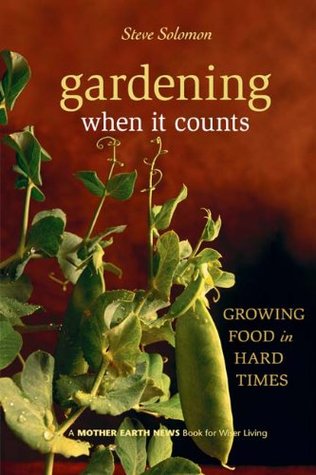More on this book
Kindle Notes & Highlights
Read between
February 10 - February 17, 2023
unwanted ones. The good guys can be helped out with crop rotation and a bit of compost. I stated a few paragraphs ago that presently my own garden for two is 2,000 square feet (200 square meters) of irrigated, well-fertilized growing beds. Now I will confess in full: I have nearly two such vegetable gardens. A large section of my land is always resting — not being fertilized, not being watered, growing rough grass and clover like a pasture. The grass areas are roughly mowed a few times each summer, and all the cuttings are allowed to lie in place to decompose. The British name for this
...more
any dictionary because I made it up. When I’d lecture, someone would always ask me if I was a vegetarian.“No,” I’d quip,“I’m a vegetableatarian. That’s a person who mostly eats mostly vegetables most of the time.” Since vegetableatarianism is my own word, it is a lot like I am — imperfect.
For every 10°F (5°C) increase in temperature, the speed of growth doubles, meaning the size increases from 1 to 2, then to 4, and then 8, 16, 32, etc.When
shovel, a common hoe, a bow rake, and a 10- to 12-inch-long (25- to 30-centimeter) metal file (with handle) to periodically sharpen the shovel and hoe.
Quality tools aren’t cheap, but they work out to be the least costly in the long run.
hold the file so that the angle between the blade and the file is about 15°.Maintain that angle firmly. Do not let the file change its angle. Now stroke the file along the edge, pressing down firmly but not so hard that you lose control of the unchanging angle of the file.
cabbage seedlings from one little tray survive. Two
successes; there are so many tomatoes to pick that the
up with considerably poorer germination.
Start solanum seeds (tomato,
Start solanum seeds (tomato, pepper, eggplant) about six weeks before you’ll want to transplant. Sow the tomatoes first. When these are up and growing, start pepper and eggplant seeds.When these are up and growing in your sunny window, consider starting the hardiest cucurbits: first the zucchini and squash. A few weeks later, after outdoor conditions have become warm and settled enough to put out the tomatoes, think about starting cucumbers and melons. Cucurbits take less than two weeks from the first sowing of seeds to the move out into the garden. This schedule works nicely with one small, heated, germination cabinet.


